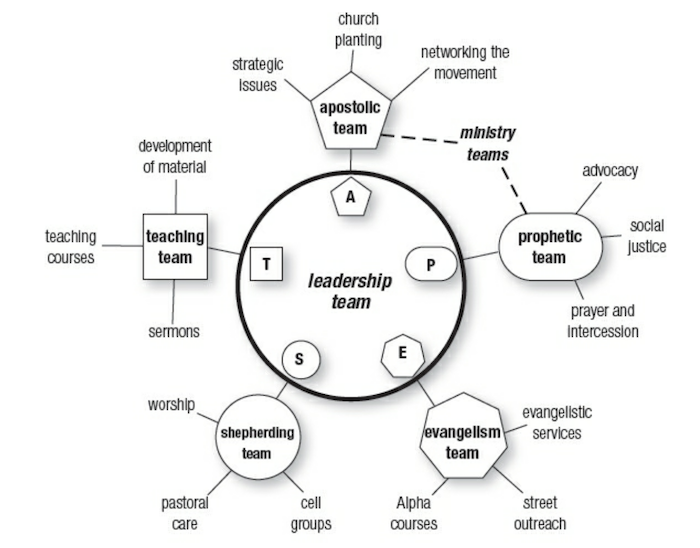Just as the various systems in the human body (e.g., circulatory, nervous, digestive) work together to sustain and enhance life, so too in all living systems the various elements in the system interrelate and serve to augment one another. Dysfunction is the result of a breakdown between various components or agents within the system. When each component operates at peak and harmonizes with the other components, the whole system is enhanced and benefits from synergy—that is, where the result is greater than the sum of the individual parts. So it is with APEST. When all five ministries are present and interrelated in an effective way, the body of Christ will operate at peak. To use Paul’s terms in Ephesians 4, it “grows,” “matures,” “builds itself up,” and “reaches unity in the faith.”
Around 2000 at South Melbourne Restoration Community, we restructured our leadership team on this principle, and it led to significant movement toward being a missional church. We restructured leadership so that we could ensure that all five ministries were represented on the team, each in turn heading up a team related to the respective APEST ministries. We had an apostolic team that focused on the translocal, missional, strategic, and experimental issues facing the church. We had a prophetic team that focused on listening to God and discerning his will for us, paying attention to social justice issues, and questioning the status quo of an increasingly middle-class church. We had an evangelistic team whose task was to oversee and develop evangelism and outreach. The pastoral (shepherding) team’s task was to develop community, cell groups, worship, and counseling and to enhance the love capacity of the church. The teaching team’s task was to create contexts of learning and to develop the love of wisdom and understanding through Bible study, theological and philosophical discussion groups, and so on. All were represented by a key leader on the leadership team. While at times it created significant debate about what the key issues facing the church were, it was thoroughly stimulating.
At the leadership-team level, we operated this model on the idea of an open learning system, which allows the team to “fit and split” and to “contend and transcend.” Fit refers to that which binds an organization together (unity). It is the group’s common ethos and purpose. Split happens when we intentionally allow for diversity of expression in the team. Contend refers to leadership permitting, even encouraging, disagreement, debate, and dialogue around core tasks (duality). Transcend means that all collectively agree to overcome disagreement in order to find new solutions (vitality, “reaching unity in the faith”).

On just about any ministry issue, the leadership team would be precommitted to the common mission of the group. We were covenanted to do “whatever it takes” to see our mission fulfilled. And given healthy relationships within the team, this meant that we allowed for the divergent opinions of each member without being offended. We had lived together, struggled together, faced issues together, and our bond to Jesus and this particular expression of his people was strong. It was this sense of fit that gave permission for each member to operate out of his or her own ministry biases and represent his or her perspectives on the issue at hand. The apostolic person would present or critique in light of the need to galvanize the community around mission. The prophetic type would challenge just about everything and ask irritating questions about how God fit into our grand schemes. The evangelist would always be trying to emphasize the need to bring people to faith and how what we suggested would achieve that. The pastoral type expressed concerns about how the community could healthily engage the issue sustainably, and the theologian would try discerning its validity from Scripture and history. The split therefore allowed for significant divergence of interests, and there were many debates, even arguments. But we would not try to resolve debate and disagreement too quickly (this drove the pastoral type nuts). We would sit with the problem until we had assessed all options and had, through dialogue and debate, arrived at the best solution—an outcome that was likely to be more true to calling, more faithful to God, sensitive to the needs of the not-yet-believers, sustainable, mature, and theologically well grounded.
APEST, if led well and directed, can operate in a very invigorating way indeed. Most churches seem to prefer more hierarchical structures with a chain-of-command approach and are most often led by people gifted as shepherds and teachers. Such ministry types can tend to avoid conflict or focus primarily on ideas and not action. The resultant organizational culture struggles to find fit and split, contend and transcend. In the operational model, decisions are made at the top and filter down to the grass roots. There is little room for any real interaction and participation around central tasks and ideas. As a result, in many denominational structures and churches the members at the “bottom” of the system can tend to feel silenced and resentful.
A bottom-up approach to APEST creates a healthy learning system: the dynamic nature of the whole matrix ensures that an open learning system results from an organization built with such leadership structures. The more outward-looking, non–status quo types (in this case A, P, and E) will ensure incoming information from outside the system and guarantee a dynamic engagement and growth with the organization’s environment. The more sustaining ministries (like S and T) will ensure that the church is not overextended beyond its capacities. All in all, it makes for a good balance of church health and missional fitness.
There is a remarkable ministry “ecology” in a fully functioning APEST system. It provides us with a theologically rich and organically consistent understanding to help leaders and organizations become more missional and agile. In fact, it would be hard not to be missional if one intentionally develops the fivefold system into the life of God’s people at the local and/or regional levels.
You can find this and more in The Forgotten Ways, by Alan Hirsch.
What is your feeling about the way South Melbourne Restoration Community utilized the APEST framework to organize their lead teams? Let us know what you are thinking about in the comments below.

